2003.04.16 12:31
Re: Fellow Americans, and those who will be but, don't know it.
As palaces are being looted in Baghdad and elsewhere in Iraq, is it not ironic that the present Liberty Bell Pavilion of the USA is also likewise slated for 'looting'?
Although still standing and indeed protected as visitors still experience the Liberty Bell inside, the building is nonetheless set to be eventually replaced, with no definitive plans for the present pavilion. Shouldn't this unique building of the USA be somehow honored, kept, preserved? If nothing is done, the pavilion will likely be dismantled and the pieces likely sold by the US Park Service.
If nothing else, perhaps the Liberty Bell Pavilion could eventually be moved to Baghdad?
or maybe:
art as architecture as art--2002.04.05
2003.04.19 22:51
liberty architecture moving to ground zero?
Does anyone else think it worthwhile beginning a 'campaign' to have the eventually former Liberty Bell Pavilion make a visit to Ground Zero?
Given the 1776' tower already proposed for the site, it might be somewhat symbolically apt for an actual '1776' building to be there for a while (1776 days?) as well--the Liberty Bell was officially moved to the new pavilion within the first hour of 1976. At least it would be better than just letting the Liberty Bell Pavilion ultimately dismantled or even just destroyed like some other symbolic building(s) in Baghdad.
Once at Ground Zero, it might be interesting for those visiting Ground Zero to also walk through the same 'space' that is walked through now and for the last 25 years to visit the Liberty Bell. Also, the Bicentennial Bell, a replica of the Liberty Bell currently hanging somewhat obscurely in a Philadelphia tower, which was presented to the people of America at Philadelphia by Queen Elizabeth II 4 July 1776, that could accompany the Liberty Bell Pavilion on its national tour.
After the Bicentennial Bell and Pavilion visits New York, it could then start a tour of the USA, visiting hundreds of cities and towns, and then come back to Philadelphia in 1776 years.
2003.04.20 10:53
liberty architecture moving to ground zero?
Would Liberty Architecture moving to Ground Zero and beyond really be just another version of Antiques Roadshow? Or could it be a way to learn and remember important things about the USA, both the good and the not so good, via symbolic architecture? I have already learned much just in hearing and seeing the response to the idea so far.
If nothing else, my hope is that the Liberty Bell Pavilion is saved rather than ultimately discarded. I've hoped this since hearing of its planned fate, and seeing the present looting of Baghdad made it clear that discarding the Liberty Bell Pavilion wouldn't be all that different.
| |
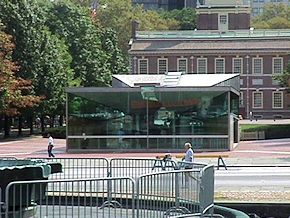 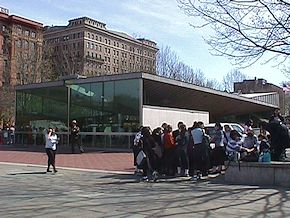 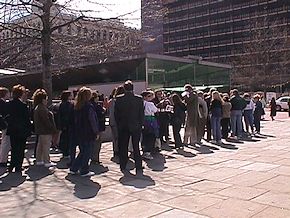 
| |
2003.04.20 17:59
liberty architecture moving to ground zero?
I just spent the better part of this afternoon at Independence National Historic Park, visiting the Liberty Bell, Independence Hall, the Bicentennial Bell Tower and several other historic buildings.
The Liberty Bell is set to be moved to the new building next to its current location sometime in September or October this year. The specific date is yet to be announced. All the National Park Service rangers I asked about the future fate of the Liberty Bell Pavilion told me it was "set to be razed." I took home a Visitors Comment Form, and I will write to the Superintendent.
Interestingly, the Liberty Bell Pavilion, as designed for the National Park Service by Mitchell/Giurgola Architects 1975-6, contains some very interesting fenestration set at very intense angles. It is a very modern building, and the only building ever designed specifically for the Liberty Bell. [I took lots of pictures today, and they will be available online soon.]
Philadelphia owns Independence Hall and the Liberty Bell. Everything else within Independence National Historic Park is under the jurisdiction (if that's the right word) of the National Park Service. So, if the Liberty Bell Pavilion is to be saved it is the National Park Service that has the power to allow that to happen.
The Citypaper spar regarding the Bicentennial Bell references the plaque in front of the tower, but a larger plaque inside the tower presents the speech with which Queen Elizabeth II represented the Bicentennial Bell, 6 July 1976--the Declaration of independence was signed 4 July 1776, but it was not publicly read until 6 July 1776, and I think that's the day the Liberty Bell cracked.
Here are the words of QEII's speech: (unfortunately one of the digital pictures I took of the plaque did not record properly, so part of the speech is missing here.)
Here on July 6, 1976, Her Majesty Queen Elizabeth II of Great Britain presented the Bicentennial Bell to the People of the United States of America with these words:
"I speak to you as the direct descent of King George III. He was the last Crowned Sovereign to rule this country, and it is therefore with a particular personal interest that I view those events which took place 200 years ago.
It seems to me that Independence Day, the Fourth of July, should be celebrated as much in Britain as in America. Not in rejoicing at the separation of the American Colonies from the British Crown but in sincere gratitude to the Founding Fathers of this great Republic for having taught Britain a very valuable lesson.
We lost the American Colonies because we lacked that statesmanship "to know the right time, and the matter of yielding, what is impossible to keep".
But the lesson was learnt. In the next century and a half we kept more closely to the principles of Magna Carta which have been the common heritage of both our countries.
We learnt to respect the right..... ......
This morning I saw the famous Liberty Bell. It came here over 200 years when Philadelphia, after London, was the largest English speaking City in the world. It was cast to commemorate the Pennsylvania Charter of Privileges, but is better known for its association with the Declaration of Independence.
Today, to mark the 20th anniversary of that declaration, it gives me the greatest pleasure, on behalf of the British people, to present a new bell to the people of the United States of America. It comes from the same foundry as the Liberty Bell, but written on the side of this Bicentennial Bell are the words "Let Freedom Ring".
It is a message in which our people can join and which will be heard around the world for centuries to come."
Given the amount of pressure that was required for the National Park Service to make acknowledgment of the Presidential slave quarters that where once at the very same spot as the entrance to the new building where to Liberty Bell is to be housed, saving the Liberty Bell Pavilion, let alone having the moved around the country, at this point seems unlikely. If there is interested for the Liberty Bell Pavilion to visit Ground Zero (and then the Pentagon, and then that field in western Pennsylvania, etc.), then the building might be saved.
| |
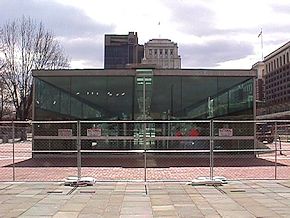 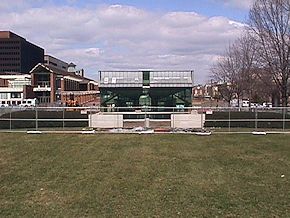  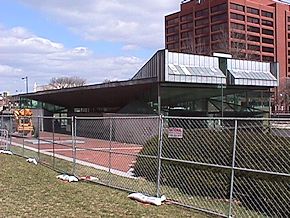
| |
2003.04.24 11:30
liberty architecture moving to ground zero?
I have not given up on 'saving' the Liberty Bell Pavilion. While the whole Pavilion may not be saved intact, pieces of the building could easily be saved. As I already mentioned here about a year ago, the Liberty Bell Pavilion comprises some incredible panes of glass. Perhaps these panes could be significantly reused within another building, like perhaps at Ground Zero. Likewise, other pieces of the Liberty Bell Pavilion could become souvenirs, like pieces of the Berlin Wall, Baghdad, etc., etc. There seem to be many ways that the Liberty Bell Pavilion could be saved.
2003.04.24 15:39
liberty architecture moving to ground zero?
The Liberty Bell Pavilion and its planned demise is a manifest example of what is both good and bad with regard to architectural symbolism, especially in the USA. You ask, "Isn't there something like a "Monument Protection Authority" or a "country conservator" in the US?" Ironically, the simple answer is that the National Park Service would be the authority that protects something like the Liberty Bell Pavilion, yet it is exactly the National Park Service that (so far) sees no reason to save the Liberty Bell Pavilion.
Who knows, maybe by this Summer there will be many that not only want to save the Liberty Bell Pavilion but also want a piece of it.
2003.12.02 17:21
so much for Liberty...
Although the quondam Liberty Bell Pavilion of Independence Historic National Park (Philadelphia) is officially for sale, the Park Service has nonetheless found a new (interim?) use for the building. It is now the security checkpoint for visitors to the Liberty Bell that is in the adjacent new Liberty Bell building. Today, while looking inside the former Liberty Bell Pavilion, I saw a man with outstretched arms being "checked" by a Park Ranger with a hand-held scanner right in front of where the Liberty Bell used to be with Independence Hall clearly in the background. Like they say, "Only in America."
2003.12.02 18:27
Re: so much for Liberty...
For several months now, I've been of the opinion that the 1976 Liberty Bell Pavilion should be moved to Shanksville, PA at the third 9-11 crash site. The building would make a very poignant memorial--during the last anniversary ceremony a bell was rung as the name of each victim was read aloud.
Seeing the old pavilion now with a new use, however, makes me think it might just stay in Philadelphia somewhat longer that so far expected.
2003.12.03 17:36
so much for liberty...
The point of this thread is... ...the ironic symbolism currently manifest by the architecture at Independence Historic National Park.
Security checkpoints at IHNP are a post-911 phenomenon, and, as far as their 'design" there goes, they are makeshift and poorly executed. Using the former Liberty Bell Pavilion now also as a checkpoint adds symbolic absurdity to the mix.
Granted this may all be temporary, but, if you are mindful of all the 200+ year history of this specific site, there's not much about it that hasn't just been temporary, or indeed ironic about the literal birthplace of the United States of America.
Perhaps the reason it is so difficult these days to design a decent memorial is because architects for almost a century now are more trained at designing oblivion.
|